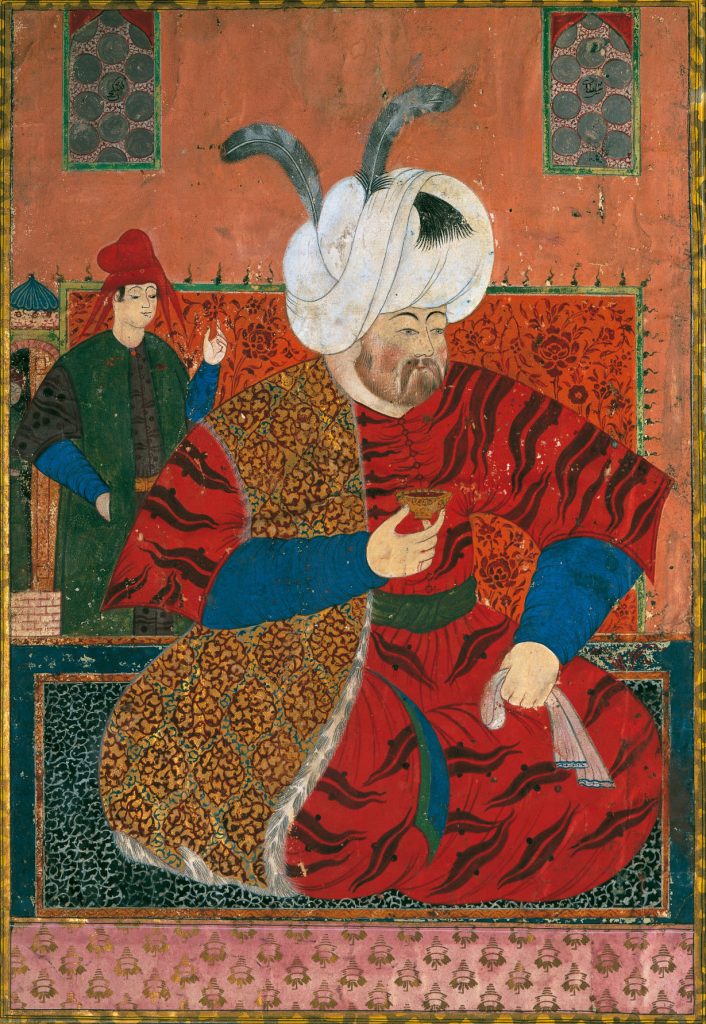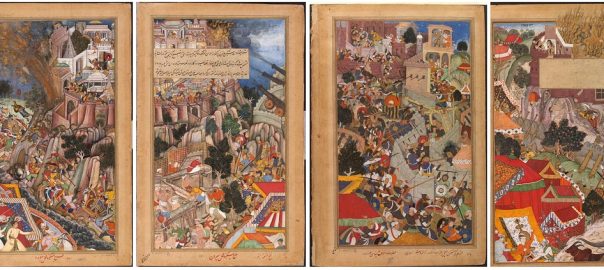On a world-historical level, the major event of 1568 CE was something that happened in India. But other interesting things were happening concerning the post-Suleiman Ottoman state– and as usual, lots of quarreling among various powers in Europe, much of it cloaked in (or stemming from?) intra-religious differences. Here we go:
- Mughal Emperor Akbar captures Chittorgarh
- Habsburgs do a deal with the Ottomans
- Many skirmishes in religious wars in France, Netherlands
- Scottish Queen flees to England
- English slavetrader Hawkins tangles with Spanish in Mexico
- New King in Kongo seeks Portuguese help
Mughal Emperor Akbar captures Chittorgarh
Since 1561, Akbar (born 1542) had been trying to extend his empire southward into Rajputana (the lands of numerous traditionally Hindu Rajput princes, rulers, etc.) One of the most formidable Rajput fortresses was the Chittorgarh (Chittor fort), believed to date back to the seventh century CE, standing atop a 152m hill and covering an area of 700 acres (2.8 km2). In October 1567, Akbar had brought an army containing untold thousands of fighters and “strong artillery” to Chittor. English-WP tells us:
After initial aggressive attempts at reaching the wall failed, Akbar ordered a complement of 5,000 expert builders, stonemasons, and carpenters to construct sabats (approach trenches) and mines to reach the walls… A large siege cannon was also cast to breach the walls once the sabat reached the objective. The fort garrison which had been observing these preparations offered to surrender…
The negotiators sent to Akbar agreed to pay a yearly tribute and enroll in his court but were rebuffed by Akbar. He wanted the main local ruler, Udai Singh, to surrender in person– but Udai Singh had fled the area a little earlier. The Mughal sappers’ digging and artillery attacks resumed.
Finally, on the night of 22 February 1568, the Mughals were able to breach the walls at several locations simultaneously. In the ensuing battle, Akbar killed the Rajput commander, Jaimal, with a musket shot. His death shattered the morale of the defenders. At that point, member of many of the Rajput families around the area committed jauhar (self-immolation.)
Also, this: “Akbar had the surviving defenders and 30,000 non-combatants massacred and their heads displayed upon towers erected throughout the region, in order to demonstrate his authority. The booty that fell into the hands of the Mughals was distributed throughout the empire…. Udai Singh’s power and influence was broken. He never again ventured out his mountain refuge in Mewar and Akbar was content to let him be.”
After taking another key fort later in the year, Akbar had effectively conquered all of Rajputana. His next military objectives were “the conquest of Gujarat and Bengal, which connected India with the trading centres of Asia, Africa, and Europe through the Arabian Sea and the Bay of Bengal respectively.”
The banner image above shows four pages from the Akbarnama depicting the taking of Chittorgarh.
Habsburgs do a deal with the Ottomans

Remember, two years ago when Suleiman the Magnificent died overlooking the battlefield of Szigetvár– and I wrote that shortly afterward the local Habsburg, Maximilian II, sent two ambassadors to sound out the new Sultan, Selim II? (Also, fwiw, known as “Selim the Sot.”) So Selim spent much of the next year sotting away, while the Grand Vizier, Sokollu Mehmed Pasha, seemed to handle most of the affairs of the Ottoman State. (Sokollu may well have engineered things over recent years so this would be the case?)
In February 1568, the Treaty of Adrianople was signed that ended the war between the Habsburg Monarchy and the Ottoman Empire. Maximilian agreed to pay an annual “present” of 30,000 ducats to the Ottomans, and essentially granted the Ottomans authority over Transylvania, Moldavia, and Wallachia. It kept the peace between the two parties for a further 25 years.
Many skirmishes in religious wars in France, Netherlands
Which to look at first– France, or Netherlands? I’ll go with Netherlands, where the Protestant-Catholic conflict was heavily overlaid with a nativist Dutch vs. Spanish conflict. Thus in 1568 we saw:
- In May, in the Battle of Heiligerlee, insurgent Dutch troops under Louis of Nassau, brother of William I of Orange, defeated a smaller Spanish force under the Duke of Arenberg. This effectively began the Eighty Years’ War, through which thre Netherlands won its independence.
- In July 21, in the Battle of Jemmingen, the main Spanish army of the Duke of Alva “utterly defeated” Louis of Nassau’s army, in the Northeastern Netherlands.
- Further fighting in October…
Now, France:
- In March, the Peace of Longjumeau ended the Second War of Religion in France. Once again, the Royalist/Catholic powers in Paris made “substantial concessions” to the Huguenots.
- In August, the Third War of Religion began in France, after an unsuccessful attempt by the Royalists to capture two key Huguenot leaders. (Spoiler alert: These Wars of Religion would continue several decades more.)
Scottish Queen flees to England
Another adventure-packed year for our young(-ish) and embattled Mary Queen of Scots! In early May, she escaped from the Scottish castle where she’d been locked up. In mid-May, at the Battle of Langside, her forces were defeated by a confederacy of Scottish Protestants, led by her half-brother James Stewart, Earl of Moray. She fled to England, where Queen Elizabeth also had her locked up.
English slavetrader Hawkins tangles with Spanish in Mexico
Remember when I told you how in 1562, the English conquistador John Hawkins inaugurated the very profitable “service” he provided to Queen Elizabeth and other well-heeled investors by pioneering the “Triangle Trade” across the Atlantic, one key leg of which involved transporting enslaved Africans from Africa to European-controlled ports in the Americas? Well, it was mainly the Spanish-controlled ports he was taking them to. But it turned out not everyone in “New Spain” (= today, Mexico) was happy about that…
In 1568, an English flotilla of six armed merchant ships under Hawkins’s command– and with his cousin Francis Drake, commanding another of the ships– had been trading along the mainland of “New Spain” with, as English-WP tells us, “the cooperation of local Spanish officials.” However the central Spanish authorities, which wanted all trade with their colonies to be conducted aboard Spanish vessels, considered this illegal.
Hawkins’ fleet anchored at San Juan de Ulúa (present day Veracruz) to resupply and repair following a storm. They were found there by two Spanish galleons carrying Martín Enríquez de Almanza, the newly appointed viceroy of New Spain. There was reportedly some contact between the two commanders. But soon after, this happened:
Spanish forces began their attack by capturing English cannons on the shore, and attempted to board the English ships. The boarding parties were initially repulsed, but the shore cannons were turned against the English ships, causing heavy damage. Only two English vessels escaped, with the other four either sunk or captured. The Spanish lost one ship. The English considered the battle an example of Spanish treachery, whilst the Spanish considered it a necessary response to criminal activity. Resentment engendered by the battle was considered a cause of the Anglo-Spanish War which broke out 17 years later.
Hawkins and Drake made it back home alive. But many of their crew members did not, and survivors were treated pretty badly by the Spanish.
New King in Kongo seeks Portuguese help
Back in 1545, we’d started to learn a bit about the Portuguese protectorate in Kongo, in West Africa. (Not co-terminous with today’s Congo.) I’m just noting here that 1568 saw the crowning of a new King, Alvaro I, who came from a different clan from the stepfather who had preceded him and therefore inaugurated a new dynasty there, called the House of Kwilu (or, Casa de Coulo.) The preceding few years in Kongo had been politically very tumultuous. English-WP tells us this:
Álvaro immediately had to fight invaders from the east (who some authorities believe were actually rebels within the country, either peasants or discontented nobles from rival factions) called the Jagas. To do this, he decided to enlist the aid of the Portuguese based at São Tomé, who sent an expedition under Francisco de Gouveia Sottomaior to assist. As a part of the same process, Álvaro agreed to allow the Portuguese to establish a colony in his province of Luanda south of his kingdom…
Álvaro also worked hard to westernize Kongo, gradually introducing European style titles for his nobles, so that the Mwene Nsundi became the Duke of Nsundi; the Mwene Mbamba became the Duke of Mbamba. The Mwene Mpemba became Marquis of Mpemba, and the Mwene Soyo became Count of Soyo…


